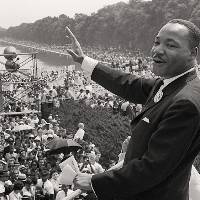Summary
Students will compare and discuss the text of the I Have a Dream Speech with the video of Dr. King speaking. Students will summarize the intent of the speech. Students will also write an essay to determine if Dr. King’s dream has been realized. They will use content from the speech and current events to support their claim.
Essential Question(s)
What was Dr. King’s intention when he delivered the I Have a Dream speech? Has the vision of Dr. King’s dream for race relations been realized?
Snapshot
Engage
Students compare paragraphs of the "I Have a Dream" speech with the video of Dr. King speaking his message. How does his passion and delivery play a part in making the message meaningful?
Explore
Through an annotating activity, students explore the text in partners and look for central ideas that identify the intent of the speech.
Explain
With their annotated text, students in teams create summary statements about the speech using the GIST method.
Extend
Students write a 4 to 5 paragraph essay with a claim statement and supporting evidence (Claim, Evidence, Reasoning) for the question: "Has the vision of Dr. King’s dream for race relations been realized?"
Evaluate
The summary statements and the essay will serve as the assessments.
Materials
Text of the "I Have a Dream" Speech (attached)
YouTube video of the "I Have a Dream" Speech
Internet and computer access for students
Rubric for student essay (attached)
Engage
Have students read the first three paragraphs of Dr. King’s speech silently. When all students have finished reading, show the same segment of the speech given by Dr. King on video.
Ask students to find a partner and discuss these questions:
Which would have the greater impact on you?
How do they differ in the delivery?
How would you compare the two versions? Explain your reasoning.
Students may want to comment on Dr. King's passion and how he strongly delivered his message. They may wish to comment on whether seeing and listening to the speech would be more powerful than reading it. You may wish to have students discuss what it might have been like to be part of the crowd at the Lincoln Memorial.
Allow time for partners to share their responses with the class.
Explore
Have students complete a text annotation activity with their partner using the rest of the "I Have a Dream" speech text. (Each student should keep their own annotated text copy because they will need their notes later.)
With their annotation notes, students should:
Circle the central ideas of Dr. King’s speech.
Underline details that support the central ideas they circled.
Make a list of vocabulary or phrases they do not understand and place that on the board as they read.
Place a question mark by ideas or information that seems confusing.
As you see students writing vocabulary on the board or putting question marks by sentences, stop and have a question and answer time where these terms are made clear. This may be when most students are nearly finished with annotation. Or you can circulate around the room and answer question marks with the student partners.
Explain
After students complete their annotations, and misconceptions and vocabulary have been discussed, have them create a 25-word Gist statement (a summary of what Dr. King meant and his purpose for this speech).
Have student partners share their summaries with the class.
Extend
Explain the rubric that is provided for students to write their essay. Students will individually write a 4-to-5 paragraph essay answering the question, "Has the vision of Dr. King’s dream for race relations been realized?"
Share the attached rubric with students so that they know the expectation for the essay.
Students should create a claim statement and support their claim with details and evidence from Dr. King’s speech and from current events about race relations or race issues. (Students will need internet access to support their claim in order to cite current race relations or race issues.)
Evaluate
The summaries and the essay will serve as the assessments. A rubric has been provided to assess the essays.
Resources
SullenToys.com. (2011, January 20). Martin Luther King - I Have A Dream Speech - August 28, 1963 [Video]. YouTube. https://www.youtube.com/watch?v=smEqnnklfYs
East Tennessee Historical Society. Martin Luther King’s "I Have a Dream" speech. Teach Tennessee History. https://teachtnhistory.org/file/I%20Have%20A%20Dream%20Speech.pdf


